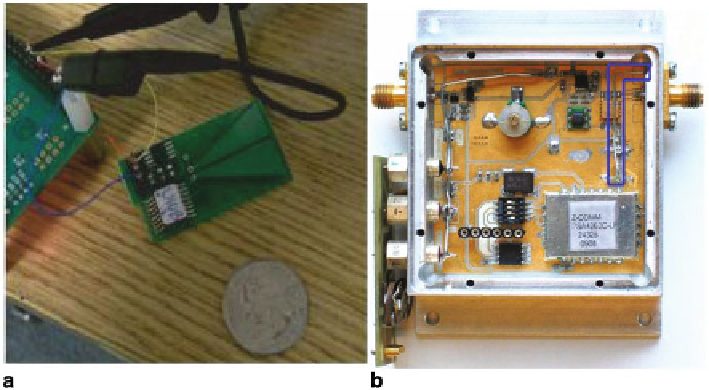Biomedical Engineering Reference
In-Depth Information
Fig. 6 a
,
b
UWB sensor implementations
.
(From [
34
] and [
35
], respectively)
combined using a balun. This method provides more controllability over the pulse
generation at the cost of increased hardware complexity.
A less complex, logic gate-based triangular pulse generation technique is sug-
gested in [
32
]. In this method, the triangular pulses generated using a combination
of XOR gates are used to periodically switch a voltage-controlled ring oscillator. In
this manner, it is possible to generate the triangular UWB pulses in the RF domain.
Because the oscillator operates only during the presence of a pulse, this method re-
duces the power wastage due to the continuous operation of local oscillators in the
other methods.
A digital-to-analog converter (DAC)- based direct UWB pulse synthesis approach
is demonstrated in [
33
] (Fig.
5
b). This technique uses a high-speed DAC in order to
synthesize accurate UWB pulse in the RF domain. This method overlooks the preci-
sion in pulse generation, hence, the achievable controllability in the pulse spectrum
over the hardware complexity. The main drawback of this approach is that the DAC
has to operate at very high sampling rates (in the order of 10 Gsps) in order to generate
the UWB pulses. This is not only challenging for the implementation of the DAC but
also the input data stream has to operate at very high rates; hence, it demands the use
of high-speed logic circuits. In general, the direct frequency UWB pulse generation
method is suitable for on-chip implementations using advanced technologies such
as CMOS due to the requirement of the high precision in circuit implementation.
Implementation of UWB Sensor Nodes
While many publications present the implementation of UWB transmitters in ICs,
only few publications present the full implementation of a UWB-based sensor plat-
forms. The work presented in [
34
] (Fig.
6
a) describes the implementation of a UWB

Search WWH ::

Custom Search